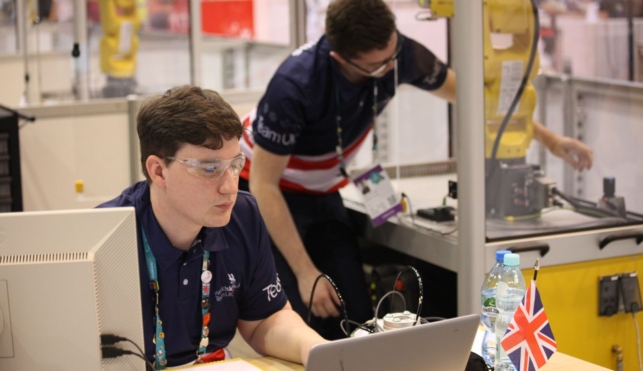Click below to see The WorldSkills International technical description for Robot Systems Integration

| Ranking | Medal | Country | Points |
| 1 | Gold | Germany | 741 |
| 2 | Silver | Chinese Taipei | 729 |
| 3 | Bronze | Poland | 723 |
| 4 | Medallion For Excellence | France | 720 |
| 5 | Medallion For Excellence | Austria | 708 |
| 6 | Medallion For Excellence | Japan | 700 |
| 7 | Hungary | 697 | |
| 8 | United Kingdom | 697 | |
| 9 | Singapore | 691 | |
| 10 | Luxembourg | 646 |
Click below to see The WorldSkills International technical description for Robot Systems Integration

The WorldSkills Occupational Standard (WSOS) specifies the knowledge, understanding, and specific skills that underpin international best practice in technical and vocational performance. It should reflect a shared global understanding of what the associated work role(s) or occupation(s) represent for industry and business
In this section of the skill fact sheet we are going to focus on two aspects of the WSOS:
| Automation & Programming | 25% of marks |
| Commissioning, Maintenance and Troubleshooting | 25% of marks |
Competence:
Excellence:
Competence:
Excellence:
To develop your practice further, you can complete our “competence to excellence” module on the WorldSkills UK Learning Lab.
The United Kingdom stands at the forefront of technological innovation, particularly in the field of robotics, showcasing a robust and dynamic engineering landscape. With a rich history in engineering excellence, the UK has consistently demonstrated a pioneering spirit in developing cutting-edge technologies. Collaborations between TVET colleges / universities and industry play a pivotal role, ensuring that theoretical advancements seamlessly translate into practical applications.
Technical engineering programs in vocational institutions and universities provide students with a comprehensive understanding of engineering, coupled with hands-on experience applicable in robotics. As the demand for robotic solutions continues to grow, the UK’s technical engineering strengths, particularly in robotics, position the nation as a global hub for innovation and excellence

Robot Systems Integration skill developed since 2019, starting with the inaugural participation in the WSI Kazan competition as an introductory skill. This event marked the introduction of tasks involving the assembly of a WorldSkills cylinder kit, where teams were tasked with assembling a cylinder within a top lid and a bottom cap. The challenge extended to include deburring, milling or turning operations, and a final microswitch quality check.
Subsequent editions of the competition have consistently introduced innovative Test Projects, pushing teams to navigate new industrial automation processes and applications. The WSI 2022 Special Edition, for instance, presented an e-commerce project centred around the selection – using QR codes and iRVision recognition – and placement of various packages onto totes transported by a conveyor to the despatch output pallet, replicating operations in an Amazon delivery centre.
As industries advance and incorporate automation into production processes, the demand for Robotics Integrators, representing the engineers of the future, continues to rise. A foundational engineering skillset at level 3 serves as a standard qualification for learners venturing into this domain, with advanced learning at levels 4-5 becoming imperative for a comprehensive understanding of interdisciplinary subjects such as engineering maths and science, CAD design, pneumatics, electrical principles and applications, process control, and more.
In-depth understanding of engineering fundamentals, including maths, science, pneumatics, electrical applications, process control, and lean manufacturing.
Ability to relate and create interdisciplinary connections between basic engineering subjects studied.
Operates with a high level of autonomy, showcasing self-reliance and independent decision-making.
Demonstrates focus and distraction control, ensuring consistent attention to tasks.
Develops a lean approach to project design in robot systems integration, emphasizing efficiency and optimization.
Reflects on organization and planning, striving for continuous improvement.
Uses visualization to aid planning, enhancing the understanding of complex processes.
Aims for excellence and effectively manages time to meet project objectives.
Continually seeks solutions to production problems and focuses on quality improvement.
Demonstrates adaptability to new environments and tasks, fostering flexibility.
Develops problem-solving strategies that can be implemented as required.
Actively engages within the team, contributing to the achievement of shared objectives.
Sets goals for self and the team, fostering a sense of direction and purpose.
Develops reflective skills and an appreciation for lean principles.
Improves organisational, time management, and goal-setting skills.
Develops communication, collaboration, and leadership skills essential for effective team dynamics.
Enhances attention to detail, critical thinking, creativity, and problem-solving skills.
Develops and applies CAD skills along with mechanical, electrical, and pneumatics principles.
Enhances practical hand-skills, decision-making, critical thinking, and problem-solving capabilities.
Understands the importance of cycle/production time and optimal use of hardware and sensors in robot cell design.
Emphasises the importance of efficient fault-finding, maintenance, and user-friendly HMI design.
Understands the significance of clear, accurate, and detailed technical specifications for end-users.